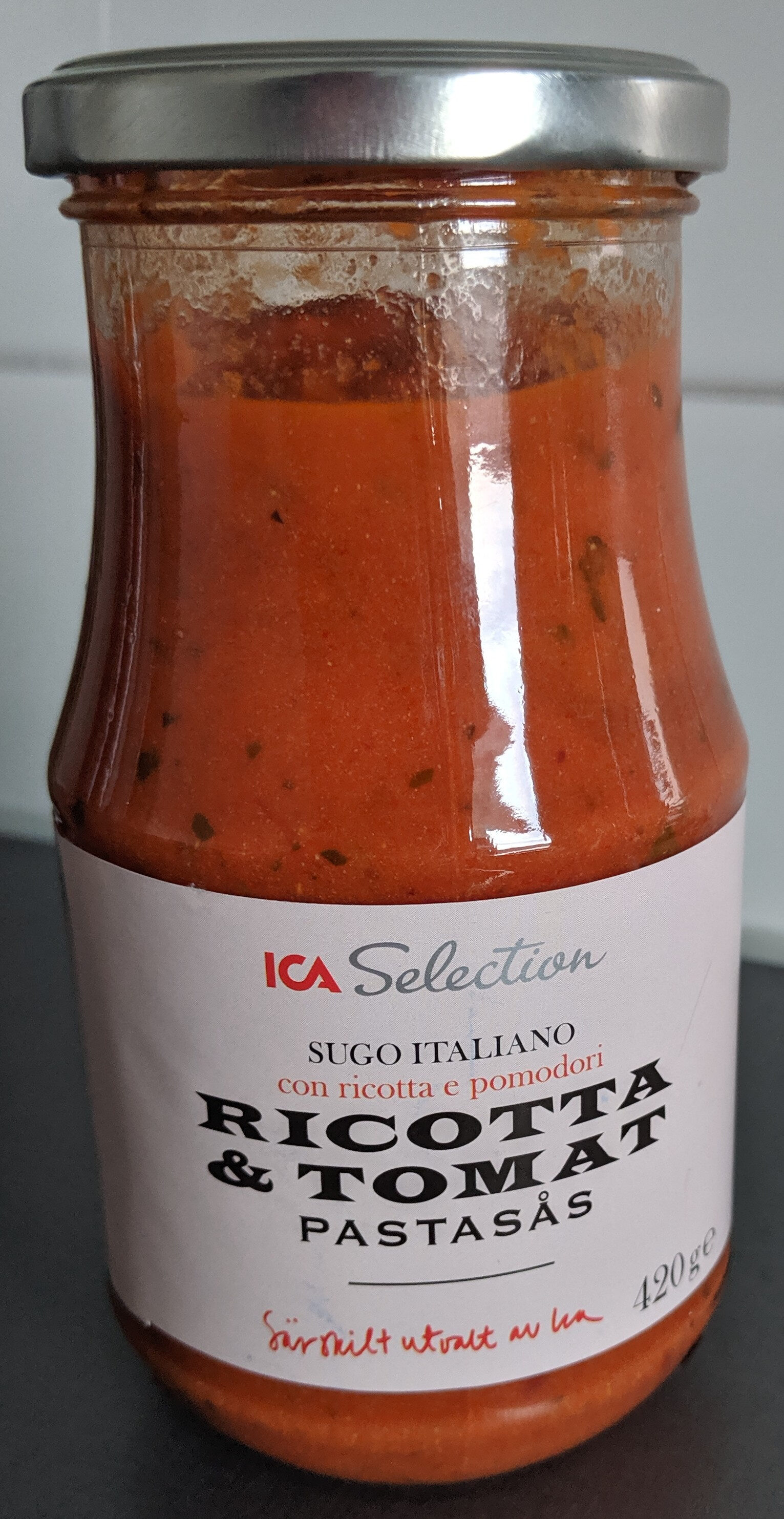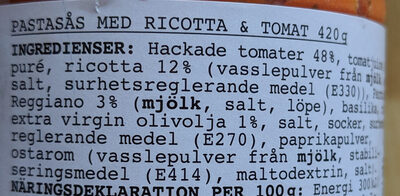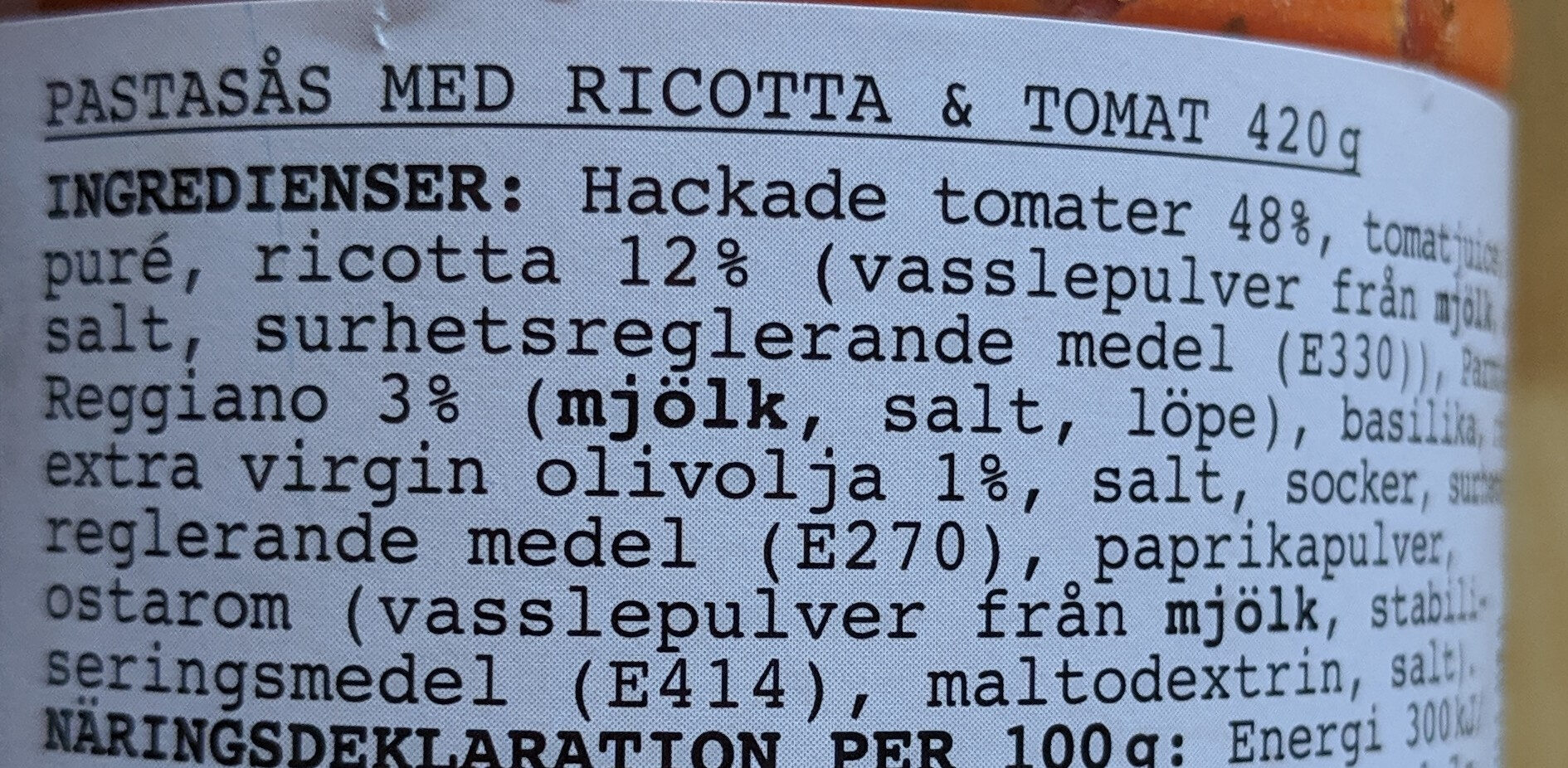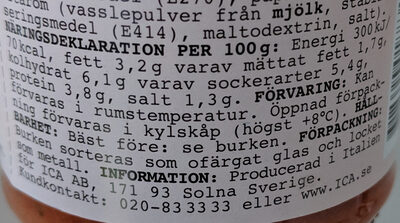Help us make food transparency the norm!
As a non-profit organization, we depend on your donations to continue informing consumers around the world about what they eat.
The food revolution starts with you!
Ricotta & Tomat Pastasås - ICA Selection - 420 g
Ricotta & Tomat Pastasås - ICA Selection - 420 g
This product page is not complete. You can help to complete it by editing it and adding more data from the photos we have, or by taking more photos using the app for Android or iPhone/iPad. Thank you!
×
Streckkod: 7318690018834 (EAN / EAN-13)
Kvantitet: 420 g
Förpackning: Glas
Varumärken: ICA Selection
Kategorier: en:Condiments, Såser, en:Pasta sauces, Tomatsåser, en:groceries
Butiker: ICA
Länder där såld: Sverige
Matching with your preferences
Hälsa
Ingredienser
-
27 ingredienser
Hackade tomater 48%, tomatjuice, tomatpuré, ricotta 12% (vasslepulver från mjölk, mjölk, salt, surhetsreglerande medel (E330)), Parmigiano-Reggiano 3% (mjölk, salt, löpe), basilika, rödlök, extra virgin olivolja 1%, salt, socker, surhetsreglerande medel (E270), paprikapulver, ostarom (vasslepulver från mjölk, stabiliseringsmedel (E414), maltodextrin, salt).Allergener: Mjölk, RicottaSpår: Mjölk
Food processing
-
Ultra processed foods
Elements that indicate the product is in the 4 - Ultra bearbetade livsmedel och drycker group:
- Tillsats: E414 - Gummi arabicum
- Ingrediens: Maltodextriner
- Ingrediens: Vassle
Food products are classified into 4 groups according to their degree of processing:
- Obearbetade eller minimalt bearbetade livsmedel
- Bearbetade kulinariska ingredienser
- Halvfabrikat
- Ultra processed foods
The determination of the group is based on the category of the product and on the ingredients it contains.
Tillsatser
-
E270 - Mjölksyra
Lactic acid: Lactic acid is an organic compound with the formula CH3CH-OH-COOH. In its solid state, it is white and water-soluble. In its liquid state, it is colorless. It is produced both naturally and synthetically. With a hydroxyl group adjacent to the carboxyl group, lactic acid is classified as an alpha-hydroxy acid -AHA-. In the form of its conjugate base called lactate, it plays a role in several biochemical processes. In solution, it can ionize a proton from the carboxyl group, producing the lactate ion CH3CH-OH-CO−2. Compared to acetic acid, its pKa is 1 unit less, meaning lactic acid deprotonates ten times more easily than acetic acid does. This higher acidity is the consequence of the intramolecular hydrogen bonding between the α-hydroxyl and the carboxylate group. Lactic acid is chiral, consisting of two optical isomers. One is known as L--+--lactic acid or -S--lactic acid and the other, its mirror image, is D--−--lactic acid or -R--lactic acid. A mixture of the two in equal amounts is called DL-lactic acid, or racemic lactic acid. Lactic acid is hygroscopic. DL-lactic acid is miscible with water and with ethanol above its melting point which is around 17 or 18 °C. D-lactic acid and L-lactic acid have a higher melting point. In animals, L-lactate is constantly produced from pyruvate via the enzyme lactate dehydrogenase -LDH- in a process of fermentation during normal metabolism and exercise. It does not increase in concentration until the rate of lactate production exceeds the rate of lactate removal, which is governed by a number of factors, including monocarboxylate transporters, concentration and isoform of LDH, and oxidative capacity of tissues. The concentration of blood lactate is usually 1–2 mM at rest, but can rise to over 20 mM during intense exertion and as high as 25 mM afterward. In addition to other biological roles, L-lactic acid is the primary endogenous agonist of hydroxycarboxylic acid receptor 1 -HCA1-, which is a Gi/o-coupled G protein-coupled receptor -GPCR-.In industry, lactic acid fermentation is performed by lactic acid bacteria, which convert simple carbohydrates such as glucose, sucrose, or galactose to lactic acid. These bacteria can also grow in the mouth; the acid they produce is responsible for the tooth decay known as caries. In medicine, lactate is one of the main components of lactated Ringer's solution and Hartmann's solution. These intravenous fluids consist of sodium and potassium cations along with lactate and chloride anions in solution with distilled water, generally in concentrations isotonic with human blood. It is most commonly used for fluid resuscitation after blood loss due to trauma, surgery, or burns.Källa: Wikipedia (Engelska)
-
E330 - Citronsyra
Citric acid: Citric acid is a weak organic acid that has the chemical formula C6H8O7. It occurs naturally in citrus fruits. In biochemistry, it is an intermediate in the citric acid cycle, which occurs in the metabolism of all aerobic organisms. More than a million tons of citric acid are manufactured every year. It is used widely as an acidifier, as a flavoring and chelating agent.A citrate is a derivative of citric acid; that is, the salts, esters, and the polyatomic anion found in solution. An example of the former, a salt is trisodium citrate; an ester is triethyl citrate. When part of a salt, the formula of the citrate ion is written as C6H5O3−7 or C3H5O-COO-3−3.Källa: Wikipedia (Engelska)
-
E414 - Gummi arabicum
Gum arabic: Gum arabic, also known as acacia gum, arabic gum, gum acacia, acacia, Senegal gum and Indian gum, and by other names, is a natural gum consisting of the hardened sap of various species of the acacia tree. Originally, gum arabic was collected from Acacia nilotica which was called the "gum arabic tree"; in the present day, gum arabic is collected from acacia species, predominantly Acacia senegal and Vachellia -Acacia- seyal; the term "gum arabic" does not indicate a particular botanical source. In a few cases so‐called "gum arabic" may not even have been collected from Acacia species, but may originate from Combretum, Albizia or some other genus. Producers harvest the gum commercially from wild trees, mostly in Sudan -80%- and throughout the Sahel, from Senegal to Somalia—though it is historically cultivated in Arabia and West Asia. Gum arabic is a complex mixture of glycoproteins and polysaccharides. It is the original source of the sugars arabinose and ribose, both of which were first discovered and isolated from it, and are named after it. Gum arabic is soluble in water. It is edible, and used primarily in the food industry as a stabilizer, with EU E number E414. Gum arabic is a key ingredient in traditional lithography and is used in printing, paint production, glue, cosmetics and various industrial applications, including viscosity control in inks and in textile industries, though less expensive materials compete with it for many of these roles. While gum arabic is now produced throughout the African Sahel, it is still harvested and used in the Middle East.Källa: Wikipedia (Engelska)
Ingrediensanalys
-
Palmoljefri
No ingredients containing palm oil detected
Okända ingredienser: OstaromVissa ingredienser kunde inte kännas igen.
Vi behöver din hjälp!
You can help us recognize more ingredients and better analyze the list of ingredients for this product and others:
- Edit this product page to correct spelling mistakes in the ingredients list, and/or to remove ingredients in other languages and sentences that are not related to the ingredients.
- Add new entries, synonyms or translations to our multilingual lists of ingredients, ingredient processing methods, and labels.
If you would like to help, join the #ingredients channel on our Slack discussion space and/or learn about ingredients analysis on our wiki. Thank you!
-
Icke-vegan
Non-vegan ingredients: Ricotta, Vasslepulver, Mjölk, Parmesan, Mjölk, VasslepulverVissa ingredienser kunde inte kännas igen.
Vi behöver din hjälp!
You can help us recognize more ingredients and better analyze the list of ingredients for this product and others:
- Edit this product page to correct spelling mistakes in the ingredients list, and/or to remove ingredients in other languages and sentences that are not related to the ingredients.
- Add new entries, synonyms or translations to our multilingual lists of ingredients, ingredient processing methods, and labels.
If you would like to help, join the #ingredients channel on our Slack discussion space and/or learn about ingredients analysis on our wiki. Thank you!
-
Vegetarisk status okänd
Okända ingredienser: OstaromVissa ingredienser kunde inte kännas igen.
Vi behöver din hjälp!
You can help us recognize more ingredients and better analyze the list of ingredients for this product and others:
- Edit this product page to correct spelling mistakes in the ingredients list, and/or to remove ingredients in other languages and sentences that are not related to the ingredients.
- Add new entries, synonyms or translations to our multilingual lists of ingredients, ingredient processing methods, and labels.
If you would like to help, join the #ingredients channel on our Slack discussion space and/or learn about ingredients analysis on our wiki. Thank you!
-
Details of the analysis of the ingredients
Vi behöver din hjälp!
Vissa ingredienser kunde inte kännas igen.
Vi behöver din hjälp!
You can help us recognize more ingredients and better analyze the list of ingredients for this product and others:
- Edit this product page to correct spelling mistakes in the ingredients list, and/or to remove ingredients in other languages and sentences that are not related to the ingredients.
- Add new entries, synonyms or translations to our multilingual lists of ingredients, ingredient processing methods, and labels.
If you would like to help, join the #ingredients channel on our Slack discussion space and/or learn about ingredients analysis on our wiki. Thank you!
: Hackade tomater 48%, tomatjuice, tomatpuré, _ricotta_ 12% (vasslepulver från mjölk, _mjölk_, salt, surhetsreglerande medel (e330)), _Parmigiano-Reggiano_ 3% (_mjölk_, salt, löpe), basilika, rödlök, extra virgin olivolja 1%, salt, socker, surhetsreglerande medel (e270), paprika, ostarom (vasslepulver från mjölk, stabiliseringsmedel (e414), maltodextrin, salt)- Hackade tomater -> en:chopped-tomatoes - vegan: yes - vegetarian: yes - ciqual_food_code: 20047 - percent_min: 48 - percent: 48 - percent_max: 48
- tomatjuice -> en:tomato-juice - vegan: yes - vegetarian: yes - ciqual_food_code: 20047 - percent_min: 12 - percent_max: 22
- tomatpuré -> en:tomato-puree - vegan: yes - vegetarian: yes - ciqual_food_code: 20170 - percent_min: 12 - percent_max: 22
- _ricotta_ -> en:ricotta - vegan: no - vegetarian: maybe - ciqual_food_code: 19585 - percent_min: 12 - percent: 12 - percent_max: 12
- vasslepulver från mjölk -> en:whey-powder - vegan: no - vegetarian: maybe - percent_min: 3.4 - percent_max: 12
- _mjölk_ -> en:milk - vegan: no - vegetarian: yes - ciqual_proxy_food_code: 19051 - percent_min: 0 - percent_max: 6
- salt -> en:salt - vegan: yes - vegetarian: yes - ciqual_food_code: 11058 - percent_min: 0 - percent_max: 1.3
- surhetsreglerande medel -> en:acidity-regulator - percent_min: 0 - percent_max: 1.3
- e330 -> en:e330 - vegan: yes - vegetarian: yes - percent_min: 0 - percent_max: 1.3
- _Parmigiano-Reggiano_ -> en:parmigiano-reggiano - vegan: no - vegetarian: maybe - ciqual_food_code: 12120 - percent_min: 3 - percent: 3 - percent_max: 3
- _mjölk_ -> en:milk - vegan: no - vegetarian: yes - ciqual_proxy_food_code: 19051 - percent_min: 1 - percent_max: 3
- salt -> en:salt - vegan: yes - vegetarian: yes - ciqual_food_code: 11058 - percent_min: 0 - percent_max: 1.3
- löpe -> en:rennet - vegan: maybe - vegetarian: maybe - percent_min: 0 - percent_max: 1
- basilika -> en:basil - vegan: yes - vegetarian: yes - ciqual_food_code: 11033 - percent_min: 1 - percent_max: 3
- rödlök -> en:red-onion - vegan: yes - vegetarian: yes - ciqual_food_code: 20034 - percent_min: 1 - percent_max: 3
- extra virgin olivolja -> en:extra-virgin-olive-oil - vegan: yes - vegetarian: yes - from_palm_oil: no - ciqual_food_code: 17270 - percent_min: 1 - percent: 1 - percent_max: 1
- salt -> en:salt - vegan: yes - vegetarian: yes - ciqual_food_code: 11058 - percent_min: 0 - percent_max: 1
- socker -> en:sugar - vegan: yes - vegetarian: yes - ciqual_proxy_food_code: 31016 - percent_min: 0 - percent_max: 1
- surhetsreglerande medel -> en:acidity-regulator - percent_min: 0 - percent_max: 1
- e270 -> en:e270 - vegan: yes - vegetarian: yes - percent_min: 0 - percent_max: 1
- paprika -> en:spice-or-bell-pepper - vegan: yes - vegetarian: yes - ciqual_food_code: 20041 - percent_min: 0 - percent_max: 1
- ostarom -> sv:ostarom - percent_min: 0 - percent_max: 1
- vasslepulver från mjölk -> en:whey-powder - vegan: no - vegetarian: maybe - percent_min: 0 - percent_max: 1
- stabiliseringsmedel -> en:stabiliser - percent_min: 0 - percent_max: 0.5
- e414 -> en:e414 - vegan: yes - vegetarian: yes - percent_min: 0 - percent_max: 0.5
- maltodextrin -> en:maltodextrin - vegan: yes - vegetarian: yes - percent_min: 0 - percent_max: 0.333333333333333
- salt -> en:salt - vegan: yes - vegetarian: yes - ciqual_food_code: 11058 - percent_min: 0 - percent_max: 0.25
Näring
-
Good nutritional quality
⚠ ️Varning: mängden fibrer är inte angiven, eventuella positiv inverkan på betyget kunde inte beaktas.⚠ ️Warning: the amount of fruits, vegetables and nuts is not specified on the label, it was estimated from the list of ingredients: 84This product is not considered a beverage for the calculation of the Nutri-Score.
Positiva poäng: 7
- Proteiner: 2 / 5 (värde: 3.8, avrundat värde: 3.8)
- Fiber: 0 / 5 (värde: 0, avrundat värde: 0)
- Frukt, grönsaker, nötter och raps- / valnöt- / olivoljor: 5 / 5 (värde: 84, avrundat värde: 84)
Negativa poäng: 7
- Energi: 0 / 10 (värde: 293, avrundat värde: 293)
- Socker: 1 / 10 (värde: 5.4, avrundat värde: 5.4)
- Mättat fett: 1 / 10 (värde: 1.7, avrundat värde: 1.7)
- Natrium: 5 / 10 (värde: 520, avrundat värde: 520)
The points for proteins are counted because the negative points are less than 11.
Näringsvärde: (7 - 7)
Nutri-Score:
-
Näringsvärden
-
Fett i måttlig kvantitet (3.2%)
What you need to know- A high consumption of fat, especially saturated fats, can raise cholesterol, which increases the risk of heart diseases.
Recommendation: Limit the consumption of fat and saturated fat- Choose products with lower fat and saturated fat content.
-
Mättat fett i måttlig kvantitet (1.7%)
What you need to know- A high consumption of fat, especially saturated fats, can raise cholesterol, which increases the risk of heart diseases.
Recommendation: Limit the consumption of fat and saturated fat- Choose products with lower fat and saturated fat content.
-
Sockerarter i måttlig kvantitet (5.4%)
What you need to know- A high consumption of sugar can cause weight gain and tooth decay. It also augments the risk of type 2 diabetes and cardio-vascular diseases.
Recommendation: Limit the consumption of sugar and sugary drinks- Sugary drinks (such as sodas, fruit beverages, and fruit juices and nectars) should be limited as much as possible (no more than 1 glass a day).
- Choose products with lower sugar content and reduce the consumption of products with added sugars.
-
Salt i måttlig kvantitet (1.3%)
What you need to know- A high consumption of salt (or sodium) can cause raised blood pressure, which can increase the risk of heart disease and stroke.
- Many people who have high blood pressure do not know it, as there are often no symptoms.
- Most people consume too much salt (on average 9 to 12 grams per day), around twice the recommended maximum level of intake.
Recommendation: Limit the consumption of salt and salted food- Reduce the quantity of salt used when cooking, and don't salt again at the table.
- Limit the consumption of salty snacks and choose products with lower salt content.
-
-
Näringsfakta
Näringsfakta Som såld
för 100 g / 100 mlCompared to: en:Pasta sauces Energi 293 kj
(70 kcal)- Fett 3,2 g +12 % Mättat fett 1,7 g +163 % Kolhydrat 6,1 g −6 % Sockerarter 5,4 g +21 % Fiber ? Protein 3,8 g +75 % Salt 1,3 g +20 % Fruits‚ vegetables‚ nuts and rapeseed‚ walnut and olive oils (estimate from ingredients list analysis) 84 %
Miljö
-
Eco-Score A - Mycket låg miljöpåverkan
The Eco-Score is an experimental score that summarizes the environmental impacts of food products.→ The Eco-Score was initially developped for France and it is being extended to other European countries. The Eco-Score formula is subject to change as it is regularly improved to make it more precise and better suited to each country.Life cycle analysis
-
Average impact of products of the same category: A (Score: 92/100)
Kategori: Tomato sauce, with onions, prepacked
Kategori: Tomato sauce, with onions, prepacked
- PEF environmental score: 0.17 (the lower the score, the lower the impact)
- including impact on climate change: 0.91 kg CO2 eq/kg of product
Stage Impact Jordbruk
47.7 %Bearbetar
19.0 %Förpackning
11.3 %Transportation
12.9 %Distribution
5.4 %Consumption
3.8 %
Bonuses and maluses
-
Missing origins of ingredients information
Malus: -5
⚠ ️ The origins of the ingredients of this product are not indicated.
If they are indicated on the packaging, you can modify the product sheet and add them.
If you are the manufacturer of this product, you can send us the information with our free platform for producers.
-
Packaging with a low impact
Malus: -2
Form Material Återvinning Impact Okänd Glas Låg ⚠ ️ The information about the packaging of this product is not sufficiently precise (exact shapes and materials of all components of the packaging).⚠ ️ For a more precise calculation of the Eco-Score, you can modify the product page and add them.
If you are the manufacturer of this product, you can send us the information with our free platform for producers.
Eco-Score for this product
-
Impact for this product: A (Score: 85/100)
Produkt: Ricotta & Tomat Pastasås - ICA Selection - 420 g
Life cycle analysis score: 92
Sum of bonuses and maluses: -7
Final score: 85/100
-
Carbon footprint
-
Equal to driving 0.5 km in a petrol car
91 g CO² per 100g of product
The carbon emission figure comes from ADEME's Agribalyse database, for the category: Tomato sauce, with onions, prepacked (Source: ADEME Agribalyse Database)
Stage Impact Jordbruk
25.6 %Bearbetar
18.5 %Förpackning
19.5 %Transportation
30.1 %Distribution
4.4 %Consumption
2.0 %
Förpackning
-
Packaging with a low impact
-
Packaging parts
(Glas)
-
Packaging materials
Material % Packaging weight Packaging weight per 100 g of product Glas
-
Transportation
-
Origins of ingredients
Missing origins of ingredients information
⚠ ️ The origins of the ingredients of this product are not indicated.
If they are indicated on the packaging, you can modify the product sheet and add them.
If you are the manufacturer of this product, you can send us the information with our free platform for producers.Add the origins of ingredients for this product Add the origins of ingredients for this product
Report a problem
-
Incomplete or incorrect information?
Category, labels, ingredients, allergens, nutritional information, photos etc.
If the information does not match the information on the packaging, please complete or correct it. Open Food Facts is a collaborative database, and every contribution is useful for all.
Datakällor
Produkt tillagd den av wolfgang8741
Senast ändrad produktsida på av packbot.
Produktsida också redigerad av jumati, openfoodfacts-contributors.









